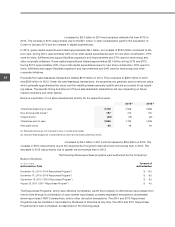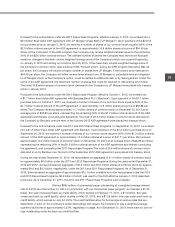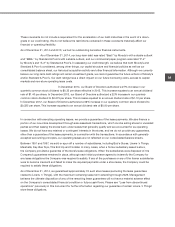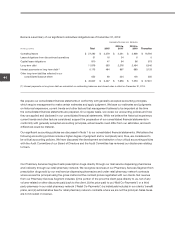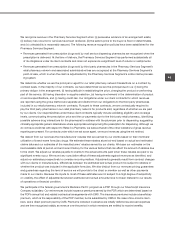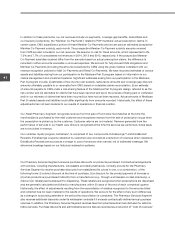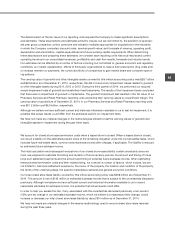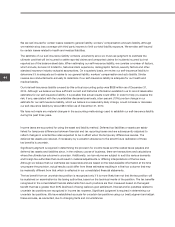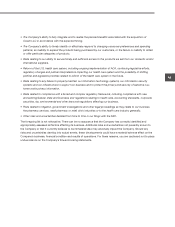CVS 2014 Annual Report Download - page 43
Download and view the complete annual report
Please find page 43 of the 2014 CVS annual report below. You can navigate through the pages in the report by either clicking on the pages listed below, or by using the keyword search tool below to find specific information within the annual report.
41
2014 Annual Report
We recognize revenue in the Pharmacy Services Segment when: (i) persuasive evidence of an arrangement exists,
(ii) delivery has occurred or services have been rendered, (iii) the seller’s price to the buyer is fixed or determinable,
and (iv) collectability is reasonably assured. The following revenue recognition policies have been established for the
Pharmacy Services Segment.
• Revenues generated from prescription drugs sold by mail service dispensing pharmacies are recognized when the
prescription is delivered. At the time of delivery, the Pharmacy Services Segment has performed substantially all
of its obligations under its client contracts and does not experience a significant level of returns or reshipments.
• Revenues generated from prescription drugs sold by third party pharmacies in the Pharmacy Services Segment’s
retail pharmacy network and associated administrative fees are recognized at the Pharmacy Services Segment’s
point-of-sale, which is when the claim is adjudicated by the Pharmacy Services Segment’s online claims process-
ing system.
We determine whether we are the principal or agent for our retail pharmacy network transactions on a contract by
contract basis. In the majority of our contracts, we have determined we are the principal due to us: (i) being the
primary obligor in the arrangement, (ii) having latitude in establishing the price, changing the product or performing
part of the service, (iii) having discretion in supplier selection, (iv) having involvement in the determination of product
or service specifications, and (v) having credit risk. Our obligations under our client contracts for which revenues
are reported using the gross method are separate and distinct from our obligations to the third party pharmacies
included in our retail pharmacy network contracts. Pursuant to these contracts, we are contractually required to
pay the third party pharmacies in our retail pharmacy network for products sold, regardless of whether we are paid
by our clients. Our responsibilities under these client contracts typically include validating eligibility and coverage
levels, communicating the prescription price and the co-payments due to the third party retail pharmacy, identifying
possible adverse drug interactions for the pharmacist to address with the physician prior to dispensing, suggesting
clinically appropriate generic alternatives where appropriate and approving the prescription for dispensing. Although we
do not have credit risk with respect to Retail Co-Payments, we believe that all of the other indicators of gross revenue
reporting are present. For contracts under which we act as an agent, we record revenues using the net method.
We deduct from our revenues the manufacturers’ rebates that are earned by our clients based on their members’
utilization of brand-name formulary drugs. We estimate these rebates at period-end based on actual and estimated
claims data and our estimates of the manufacturers’ rebates earned by our clients. We base our estimates on the
best available data at period-end and recent history for the various factors that can affect the amount of rebates due
to the client. We adjust our rebates payable to clients to the actual amounts paid when these rebates are paid or as
significant events occur. We record any cumulative effect of these adjustments against revenues as identified, and
adjust our estimates prospectively to consider recurring matters. Adjustments generally result from contract changes
with our clients or manufacturers, differences between the estimated and actual product mix subject to rebates or
whether the product was included in the applicable formulary. We also deduct from our revenues pricing guarantees
and guarantees regarding the level of service we will provide to the client or member as well as other payments
made to our clients. Because the inputs to most of these estimates are not subject to a high degree of subjectivity
or volatility, the effect of adjustments between estimated and actual amounts have not been material to our results
of operations or financial condition.
We participate in the federal government’s Medicare Part D program as a PDP through our SilverScript Insurance
Company subsidiary. Our net revenues include insurance premiums earned by the PDP, which are determined based on
the PDP’s annual bid and related contractual arrangements with CMS. The insurance premiums include a beneficiary
premium, which is the responsibility of the PDP member, but is subsidized by CMS in the case of low-income mem-
bers, and a direct premium paid by CMS. Premiums collected in advance are initially deferred as accrued expenses
and are then recognized ratably as revenue over the period in which members are entitled to receive benefits.







